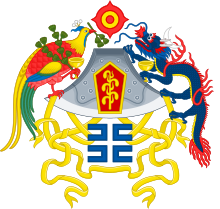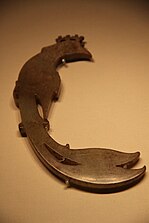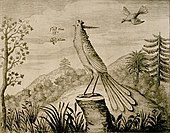Fenghuang
 | |
| Grouping | Mythical creature |
|---|---|
| Sub grouping | phoenix |
| Folklore | Chinese mythology |
| Other name(s) | Chinese phoenix |
| Country | China |
| Fenghuang | |||||||||||||||||||||||||||||||||||||||||||
|---|---|---|---|---|---|---|---|---|---|---|---|---|---|---|---|---|---|---|---|---|---|---|---|---|---|---|---|---|---|---|---|---|---|---|---|---|---|---|---|---|---|---|---|
| Chinese name | |||||||||||||||||||||||||||||||||||||||||||
| Traditional Chinese | Phượng hoàng | ||||||||||||||||||||||||||||||||||||||||||
| Simplified Chinese | Phượng hoàng | ||||||||||||||||||||||||||||||||||||||||||
| Hanyu Pinyin | fènghuáng | ||||||||||||||||||||||||||||||||||||||||||
| |||||||||||||||||||||||||||||||||||||||||||
| Vietnamese name | |||||||||||||||||||||||||||||||||||||||||||
| Vietnamese Alpha bet | Phượng hoàng Phụng hoàng | ||||||||||||||||||||||||||||||||||||||||||
| Chữ Hán | Phượng hoàng | ||||||||||||||||||||||||||||||||||||||||||
| Korean name | |||||||||||||||||||||||||||||||||||||||||||
| Hangul | 봉황 | ||||||||||||||||||||||||||||||||||||||||||
| Hanja | Phượng hoàng | ||||||||||||||||||||||||||||||||||||||||||
| |||||||||||||||||||||||||||||||||||||||||||
| Japanese name | |||||||||||||||||||||||||||||||||||||||||||
| Kanji | Phượng hoàng | ||||||||||||||||||||||||||||||||||||||||||
| Hiragana | ほうおう | ||||||||||||||||||||||||||||||||||||||||||
| |||||||||||||||||||||||||||||||||||||||||||
Fènghuáng(Chinese:Phượng hoàng;Jyutping:fung6 wong4;Cantonese Yale:fuhng wòhng,Mandarin pronunciation:[fə̂ŋ.xwǎŋ]) aremythologicalbirds found inSinosphericmythology that reign over all other birds. Themaleswere originally calledfèngand thefemaleshuáng,but this distinction of gender is often no longer made and they are blurred into a single feminine entity so that the bird can be paired with theChinese dragon,which is traditionally deemed male.
It is known under similar names in various other languages (Japanese:hōō;Vietnamese:phượng hoàngorphụng hoàng;Korean:bonghwang). In theWestern world,it is commonly called theChinese phoenixor simplyphoenix,although mythological similarities with the Westernphoenixare superficial.[citation needed]
Appearance[edit]

A common depiction of fenghuang was of it attacking snakes with its talons and its wings spread. According to theErya's chapter 17Shiniao,fenghuang is made up of the beak of arooster,the face of aswallow,the forehead of afowl,the neck of asnake,the breast of agoose,the back of atortoise,the hindquarters of astagand the tail of afish.[1]Today, however, it is often described as a composite of many birds including the head of agolden pheasant,the body of amandarin duck,the tail of apeacock,the legs of acrane,the mouth of aparrot,and the wings of aswallow.[citation needed]
The fenghuang's body symbolizes the celestial bodies: the head is the sky, the eyes are the sun, the back is the moon, the wings are the wind, the feet are the earth, and the tail is the planets.[2]The fenghuang is said to have originated in the sun.[2]Its body contains the five fundamental colors: black, white, red, yellow, and green.[2]It sometimes carries scrolls or a box with sacred books.[2]It is sometimes depicted with a fireball.[2]It is believed that the bird only appears in areas or places that are blessed with utmost peace and prosperity or happiness.
Chinese tradition cites it as living atop theKunlun Mountainsin northern China.[citation needed]
Origin[edit]

The earliest known ancient phoenix design dates back to about 7000–8000 years ago and was discovered inHong gian g,Hunan Province,at the Gaomiao Archeological Site.[3]The earliest known form of dragon-phoenix design, on the other hand, dates back to theYangshao culture(c. 5000– c. 3000BC) and was found at an archeological site nearXi'aninShaanxi Province.[3]This ancient usage ofphoenixanddragondesigns are all evidence of an ancient form oftotemismin China.[3]
During theShang dynasty,phoenix anddragonimages appear to have become popular as burial objects.[3]Several archeological artifacts of jade phoenix and jade dragons were unearthed in tombs dating from the Shang dynasty period.[3]

During theSpring and Autumn period(c.771 – c.476BC) and theWarring States period,common form of unearthed artifacts is the combination of dragon-phoenix designs together.[3]One such artifact is theSilk Painting of Human Figure with Dragon and Phoenix,pictured left.[3][4]
In theQin dynasty(221–206 BC), phoenixhairpins(i.e. hairpins withfenghuangdecorations) and shoes which were also decorated with phoenix designs were supposed to be worn by the Imperial concubines of the Qin Emperor.[3]
During theHan dynasty(2,200 years ago) two phoenixes, one a male (feng,Phượng) and the other a female (huang,Hoàng) were often shown together facing one other.[citation needed]In theHan dynasty,an imperial edict decreed that the phoenix hairpins had to become the formal headpiece for theempress dowagerand the imperial grandmother.[5]

Later, during theYuan dynastythe two terms were merged to becomefenghuang,but the "King of Birds" came to symbolize the empress when paired with a dragon representing the emperor.

From theJiajing era(1522–1566) of theMing dynastyonwards, a pair of phoenixes was differentiated by the tail feathers of the two birds, typically together forming a closed circle pattern – the male identified by five long serrated tail feathers or "filaments" (five being an odd, masculine, oryangnumber) and the female by what sometimes appears to be one but is in fact usually two curling or tendrilled tail feathers (two being an even, feminine, oryinnumber). Also during this period, thefenghuangwas used as a symbol representing the direction south. This was portrayed through a male and female facing each other. Their feathers were of the five fundamental colors: black, white, red, green, and yellow. These colours are said to representConfucius' five virtues:
- Ren:the virtue of benevolence, charity, and humanity;
- Yi:honesty and uprightness;Yìmay be broken down intozhōng,doing one's best, conscientiousness, loyalty andshù:the virtue of reciprocity, altruism, consideration for others
- Zhi:knowledge
- Xin:faithfulness and integrity;
- Li:correct behavior, propriety, good manners, politeness, ceremony, worship.[6]
The phoenix represented power sent from the heavens to the Empress. If a phoenix was used to decorate a house it symbolized that loyalty and honesty were in the people that lived there. Or alternatively, a phoenix only stays when the ruler is without darkness and corruption (Chính trị thanh minh).
Etymology and meaning[edit]
Etymology[edit]
LinguistWang Lirelates elementPhượng,OC:*bums(ZS),mod.fèngtoBằng,OC:*bɯːŋ(ZS)"peng,fabulous great bird ";[7]Phượngis also related to*plum,OC:*Phong,mod.fēng"wind".[8]
Historical linguistMarc MiyakereconstructsPhượng hoàng,OC:*N-prəm-sɢʷˁɑŋ,mod.fènghuáng,which he proposes, though with uncertainty, to be the affixed form ofPhong hoàng,OC:*prəm[ɢ]ʷˁɑŋ(B&S),mod.fēng huáng"wind sovereign".[9]
Meaning[edit]

The fenghuang has positive connotations. It is a symbol of virtue and grace. The fenghuang also symbolizes the union ofyin and yang.[citation needed]The first chapter of theClassic of Mountains and Seas,the "Nanshang-jing", states that each part of fenghuang's body symbolizes a word. The head representsvirtue(Đức), the wing representsduty(Nghĩa), the back representspropriety(Lễ), the abdomen represents credibility (Tin) and the chest representsmercy(Nhân).[10]
Thefenghuangoriginally consisted of a separate malefengand a femalehuangassymbolsof yin and yang.[3][11]The malefengrepresented theyangaspect while thehuangrepresented theyinaspect; and together, the feng and huang image was symbolic of love between husband and wife.[11]However, since theQin dynasty,thefenghuangprogressively went through a feminization process as the dragon became a symbol of masculinity.[3]Eventually, thefengand thehuangmerged into a single female entity.[11]
In ancient and modern Chinese culture,fenghuangcan often be found in the decorations forweddingsorroyalty,along withdragons.This is because the Chinese considered the dragon-and-phoenix design symbolic of blissful relations between husband and wife, another commonyang and yinmetaphor. In some traditions, it appears in good times but hides during times of trouble, while in other traditions it appeared only to mark the beginning of a new era.[12]In China and Japan, it was a symbol of the imperial house, and it represented "fire, the sun, justice, obedience, and fidelity".[12]
-
A fenghuang on the roof ofLongshan TempleinTaipei
-
Drawing of aFum Hoam(fenghuang) by aDutchman, circa 1664.
-
Classic of Mountains and Seasillustration of a nine-headed phoenix (coloredQing Dynastyedition)
-
Portrait of an empress, possiblyEmpress Xiaoxianchun,(wife of theQianlong Emperor) sitting on a chair decorated with phoenixes
Modern usage[edit]
The phoenix is still used in modern Japan and Korea in relation to the head of state:
- Japan: TheHōō(ほうおう,[hoːoꜜː],the Japanese pronunciation of phượng hoàng ) is associated with the Japanese Imperial family. The seemingly vast difference betweenhōōandfenghuangis due to Chinese vowels withngusually being converted toōingo-onreading. Examples include:
- The actual Imperial throneTakamikura(Cao ngự tòa)is adorned by numerousHōōs.
- The Imperial regaliaKōrozen no Gohō(Hoàng lư nhiễm ngự bào) is decorated by numerous textile patterns including a pair ofHōō.
- Various Japanese stamps and currency, such as the back of the current series E (2004)¥10,000 yen note.
- Toyota's flagship vehicle favored by the Japanese Imperial family and high Japanese government officials, theToyota Century,uses theHōōas an identifying emblem.[13]
- Korea: twobonghwang(봉황,Korean pronunciation of phượng hoàng ) are used in the symbol of the Korean President. Historically thebonghwangwas used for queens and empresses.[citation needed]
Other uses include:
- FèngorFènghuángis a common element ingiven namesof Chinese women (likewise, "Dragon"is used for men's names).
- "Dragon-and-phoenix infants "(Long phượng thai;Long phượng thai) is a Chinese term for a set of male and femalefraternal twins.
- Fenghuang is a common place name throughout China. The best known isFenghuang Countyin westernHunan,southern China, formerly asub-prefecture.Its name is written with the same Chinese characters as the mythological bird.
- Phoenix talons(Cánh gà;Cánh gà) is a Chinese term for chicken claws in any Chinese dish cooked with them.
- TheVermilion Bird,(Suzakuin Japanese) one of theFour Symbols of Chinese myth,sometimes equated with the fenghuang.[14]
- TheChinese University of Hong Kong(CUHK) uses it in its emblem to symbol nobility, beauty, loyalty and majesty.[15]
- Phoenix Television(Phượng hoàng vệ tinh TV) is aHong Kong-based media company
- Typhoon Fung-wonghas been a meteorological name for three tropical cyclones. The term was contributed byHong Kongand is theCantonesepronunciation offenghuang.
- When describingchinoiserieor authentic Asian ceramics and other artworks, English-speaking art historians and antique collectors sometimes refer to it as "hoho bird",[16]a name derived fromhōō,with a second extraneoushadded. The Japanese also use the wordfushichōfor this image.
-
Phoenix sculpture inFenghuang mountain,Fengcheng.
-
Dragon & Phoenix Arch in China
-
Seal of the South Korean President, with twin phoenix emblem.
-
Phoenix sculpture by theBlue House(former residence of the Korean President).
-
The emblem of CUHK is the mythical Chinese birdfeng(Phượng) which has been regarded as the Bird of the South since the Han dynasty. It is a symbol of nobility, beauty, loyalty and majesty. The University colours are purple and gold, representing devotion and loyalty, and perseverance and resolution, respectively.
See also[edit]
- Birds in Chinese mythology
- Chinese mythology
- Four Holy Beasts
- Byōdō-in,Buddhist temple in Japan
- Byodo-In Temple,Buddhist temple in Oʻahu, Hawaiʻi
- Firebirdin Russian mythology
- Garudain Hindu mythology
- Lạc birdin Viet mythology
- Hōō, the Japanese name for the Fènghuáng
- Huma birdin Persian mythology
- Phoenix(manga)
- Phoenix (mythology)
- Phoenix Program,Vietnam War operation by the US
- Phoenix Mountain,a mountain inZhe gian g,China
- Roc (mythology)in Middle Eastern mythology
- Simurgh,an Iranian mythological bird identifiable with the phoenix
- Turulin Hungarian mythology
References[edit]
- ^《 nhĩ nhã · thích điểu 》 quách phác chú, phượng hoàng đặc trưng là: "Đầu gà, yến cằm, xà cổ, quy bối, đuôi cá, năm màu sắc, cao sáu thước hứa".
- ^abcdeNozedar, Adele (2006).The secret language of birds: A treasury of myths, folklore & inspirational true stories.London: HarperElement. p. 37.ISBN978-0007219049.
- ^abcdefghijHu, Jiaxiang (2019).Study on Chinese traditional theory of artistic style.New Jersey: World Scientific. pp. 34–36.ISBN978-981-327-943-8.OCLC1222224249.
- ^"Silk painting with female figure, dragon and phoenix patterns | Hồ Nam tỉnh viện bảo tàng".hnmuseum.Retrieved2021-06-18.
- ^Cheng, Hui-Mei (2001)."Research on the Form and Symbolism of the Chinese Wedding Phoenix Crown".Proceedings of the Korea Society of Costume Conference:59–61.
- ^"Confucius' Five Virtues".Archived fromthe originalon 2011-07-07.Retrieved2011-06-12.
- ^Wang, Li ( vương lực ) (1982). 《 cùng nguyên từ điển 》 (Dictionary of Word Families). Beijing: Commercial Press. p. 318. Cited in Schuessler, Axel (2007).ABC Etymological Dictionary of Old Chinese,Honolulu: University of Hawaii Press. p. 239
- ^Schuessler, Axel (2007).ABC Etymological Dictionary of Old Chinese,Honolulu: University of Hawaii Press. p. 239
- ^Miyake, Marc (5-6 November 2015) "Old Chinese type A/type B in areal perspective: Recent Advances in Old Chinese Phonology beyond Boundaries",a talk given atRecent Advances in Old Chinese Historical Phonologyheld at SOAS, University of London; under the auspices of the European Research Council Grant Beyond Boundaries: Religion, Region, Language and the State. Slide 43 of 49
- ^Shan Hai Jing- chapter 1. "Nanshang Jing" - Nan Ci San Jing:Có điểu nào, này trạng như gà, năm thải mà văn, tên là phượng hoàng, đầu văn rằng đức, cánh văn rằng nghĩa, bối văn rằng lễ, ưng văn rằng nhân, bụng văn rằng tin. Là điểu cũng, ẩm thực tự nhiên, tự ca tự vũ, thấy tắc thiên hạ an bình.
- ^abcRosen, Brenda (2009).The mythical creatures bible: the definitive guide to legendary beings.New York: Sterling. p. 151.ISBN978-1-4027-6536-0.OCLC244063992.
- ^abSources:
- "Hou-ou (or Hoo-oo)".It's rumored to only land in areas where there is something precious underneath. Such as so, in one story, a man who saw a Fenghuang land on a patch of ground later returned to dig in that area andsaltwas discovered.
- "The phoenix in Egyptian, Arab and Greek mythology".
- ^Lim, Brandon (26 June 2019)."How the Toyota Century Rivals Rolls-Royce".Motortrend.Retrieved1 November2021.
- ^Definitions of Chinese Phoenix and Chinese Vermillion Bird
- ^"Mission & Vision, Motto & Emblem | About CUHK".cuhk.edu.hk.Retrieved2019-02-08.
- ^Examples (retrieved 3 July 2013): Cosgrove, Maynard Giles (1974).The Enamels of China and Japan: Champlevé and Cloisonné.Hale. p. 75.ISBN978-0-7091-4383-3. Catherine Pagani (2001).Eastern Magnificence and European Ingenuity: Clocks of Late Imperial China.University of Michigan Press. p. 131.ISBN978-0-472-11208-1. Van Goidsenhoven, J. P. (1936).La Céramique chinoise sous les Tsing: 1644–1851.R. Simonson. p. 215.
External links[edit]
 Media related toFenghuangat Wikimedia Commons
Media related toFenghuangat Wikimedia Commons









